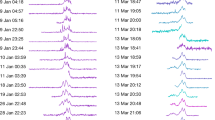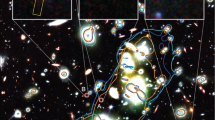Abstract
As part of a programme of multifrequency single epoch observations of BL Lac objects and flat-spectrum radio sources we have examined the radio source OV236 (1921–293) which has been classified both as a quasar and a BL Lac object. Its polarization and variability at 2.2 µm1 and generally featureless optical spectrum are consistent with it being a BL Lac object. Wills and Wills2 measured its optical polarization, variability and emission line spectrum and find it to have a redshift z = 0.352. It is an extremely variable radio source, during the outburst reported by Dent and Balonek3 it was the brightest 10-cm quasar in the sky. The outburst was first measured at 3.3 mm and was increasingly delayed at longer wavelengths; there was also evidence for correlated optical/radio variability during this outburst4. We have obtained J, H, K, 10, 20, 800 and 1,100 µm flux measurements of 1921–293 over a period of four days from the same telescope, enabling us to present a ‘snapshot’ of its IR to millimetre spectrum. The continuum spectrum of 1921–293 is suggestive of a peak in the submillimetre region. This excess could be due to an injection of high-energy electrons into a synchrotron emitting region, although thermal emission from dust remains a possibility.
This is a preview of subscription content, access via your institution
Access options
Subscribe to this journal
Receive 51 print issues and online access
$199.00 per year
only $3.90 per issue
Buy this article
- Purchase on Springer Link
- Instant access to full article PDF
Prices may be subject to local taxes which are calculated during checkout
Similar content being viewed by others
References
Impey, C. D., Brand, P. W. J. L., Wolstencroft, R. D. & Williams, P. M. Mon. Not. R. astr. Soc. 200, 19 (1982).
Wills, D. & Wills, D. J. Nature 289, 384 (1981).
Dent, W. A. & Balonek, T. J. Nature 283, 747 (1980).
Gilmore, G. Nature 287, 612 (1980).
Cunningham, C. T. thesis, Univ. London (1982).
Robson, E. I. in Proc. ESA Workshop Noordwijkerhout, ESA Sp-189, 147 (1982).
Rowan-Robinson, M., Clegg, P. E. & Ade, P. A. R. Mon. Not. R. astr. Soc. 172, 603 (1975).
Cunningham, C. T., Ade, P. A. R., Robson, E. I., Nolt, I. G. & Radostitz, J. V. Icarus 48, 127 (1981).
Elias, J. H., Frogel, J. A., Matthews, K. & Neugebauer, G. Astr. J. 87, 1029 (1982).
O'Dell, S. L. et al. Astrophys. J. 224, 22 (1978).
Ennis, D. J., Neugebauer, G. & Werner, M. Astrophys. J. 262, 460 (1982).
Telesco, C. M. & Harper, D. A. Astrophys. J. 235, 392 (1980).
Lee, T. J. et al. Nature 295, 264 (1982).
Harvey, P. M., Wilking, B. A. & Joy, M. Astrophys. J. Lett. 254, L29 (1982).
Clegg, P. E. et al. Astrophys. J. (submitted) (1982).
Bregman, J. N. et al. Nature 293, 714 (1981).
Puschell, J. J. et al. Astrophys. J. Lett. 227, L11 (1979).
Ennis, D. J., Neugebauer, G. & Werner, M. Astrophys. J. 262, 451 (1982).
Author information
Authors and Affiliations
Rights and permissions
About this article
Cite this article
Gear, W., Robson, E., Ade, P. et al. Multifrequency observations of OV236 (1921–293) reveal an unusual spectrum. Nature 303, 46–47 (1983). https://doi.org/10.1038/303046a0
Received:
Accepted:
Issue Date:
DOI: https://doi.org/10.1038/303046a0
This article is cited by
-
Mauna Kea telescope debate
Nature (1983)
Comments
By submitting a comment you agree to abide by our Terms and Community Guidelines. If you find something abusive or that does not comply with our terms or guidelines please flag it as inappropriate.



